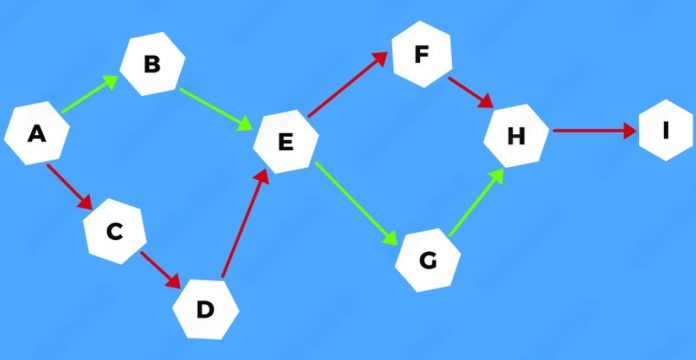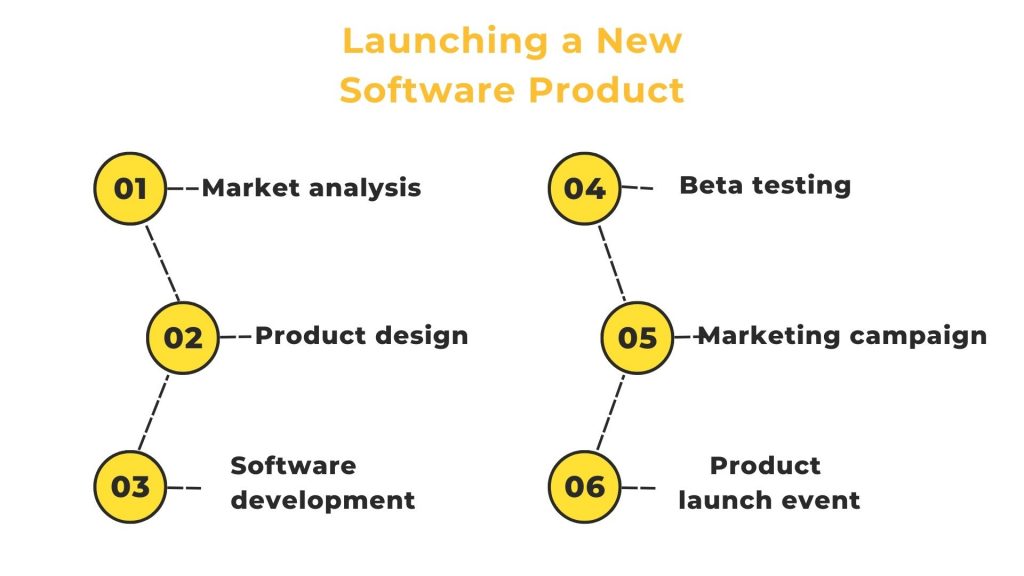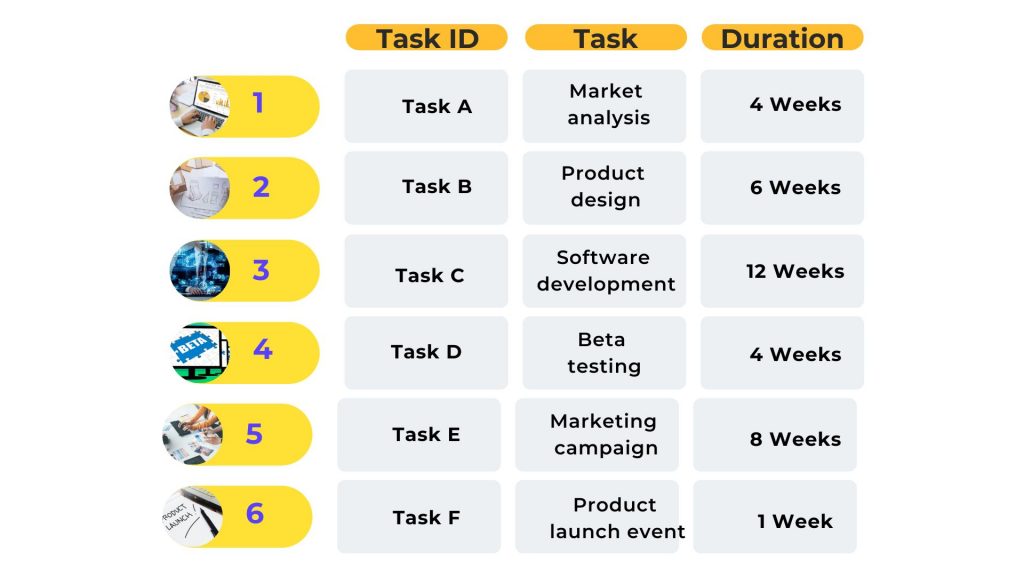
Creating a project roadmap is instrumental in outlining the necessary steps to achieve your final objective. The Critical Path Method (CPM) facilitates this by identifying and organizing the tasks required for project completion. This project management strategy is crucial for coordinating task interdependencies and establishing feasible deadlines.
In this blog, we will discover the workings of the Critical Path Method and its application with your team to enhance the efficiency of project timelines.
What Is a Critical Path in Project Management?
In project management, the critical path is identified as the sequence of crucial tasks that stretches across the entire length of the project schedule. It’s essentially the backbone of the project’s timeline, representing the longest path through its task network.
Each task on this path is interdependent, meaning the initiation of each subsequent task relies on completing the preceding one. This series of tasks dictates the shortest possible duration to complete the project. Any delay in these critical tasks, therefore, has a cascading effect, prolonging the overall project end date.
Project managers employ the Critical Path Method (CPM) as a strategic tool to ascertain and outline this critical path. By doing so, they can monitor the project’s progress with precision, manage resources effectively, and make informed decisions about where to allocate time and effort. The critical path also provides a visual representation of task dependencies, which is crucial for adjusting project plans and aligning them with desired deadlines, thus ensuring timely project delivery.
What is the Critical Path Method?
The Critical Path Method (CPM) is a straightforward yet potent tool for the analysis, planning, and scheduling of substantial, intricate projects. It pinpoints the longest sequence of indispensable tasks, the critical path, which dictates the timeframe for the entire project’s completion. Known alternatively as Critical Path Analysis (CPA), CPM clarifies the interdependencies among tasks and identifies which are vital for the project’s success.
Regarded as a fundamental concept in project management, the Critical Path Method boasts a rich history, with its early forms dating back to the Manhattan Project during the 1940s. It was among the strategies devised to ensure timely results for this significant endeavor.
This method delineates crucial tasks to forecast a project’s finish date. In contemporary project management, CPM remains a pivotal aspect of project planning. The duration and significance of the key tasks are what typically defines the overall project timeline and financial planning.
Why Conduct Critical Path Analysis?
Conducting Critical Path Analysis (CPA) is a strategic approach in project management for several reasons. Let us break down all those reasons:
- Enhances Timing Accuracy: CPA allows project managers to estimate the minimum project duration more accurately by identifying the longest stretch of dependent activities.
- Identifies Priority Tasks: It highlights which tasks must be completed on time to prevent delays, enabling teams to prioritize work more effectively.
- Resource Allocation: Understanding the critical path helps in the efficient allocation of resources, ensuring that critical tasks have the necessary resources when needed.
- Risk Management: CPA enables teams to foresee potential bottlenecks and plan risk mitigation strategies for tasks that could impact the project timeline.
- Improves Flexibility: By revealing the sequence of tasks that are not on the critical path, CPA provides insight into where there is slack in the schedule. This can help in understanding where schedules can be adjusted if necessary.
- Facilitates Communication: CPA serves as a communication tool that provides stakeholders with a clear picture of project scheduling and critical tasks.
- Optimizes Process Improvement: Regular analysis of the critical path can highlight recurring delays, prompting process improvements for future projects.
Critical Path Analysis is crucial for planning, executing, and managing projects efficiently, ensuring project objectives are met on time and within scope.
Benefits of Using the Critical Path Method in Project Management
The Critical Path Method (CPM) is required in project management, serving as a strategic framework for identifying the sequence of essential tasks that dictate a project’s timeline. By mapping out each task’s dependencies and durations, CPM allows managers to pinpoint the most efficient path to project completion.
CPM methodology not only helps to keep the project scope under control but also ensures that the project stays on track by highlighting the critical tasks, estimating their durations, managing resources effectively, and identifying potential risks. Implementing CPM is foundational for delivering projects on time and within the planned scope, making it an essential practice in project management.
- Task Identification: CPM rigorously identifies every task required for project completion, ensuring comprehensive project scope management.
- Time Management: It distinguishes tasks with strict deadlines from those with scheduling flexibility, helping to maintain project timelines.
- Resource Allocation: By determining the float or slack, CPM assists in prioritizing tasks and efficiently allocating resources.
- Dependency Mapping: CPM allows for the identification of task dependencies, resource constraints, and potential project risks, promoting proactive management.
- Critical Task Focus: It highlights tasks with zero slack, ensuring these are prioritized to avoid delays in the project timeline.
- Progress Monitoring: CPM is instrumental in tracking project progress and measuring any variances from the schedule.
- Schedule Optimization: It provides strategies for schedule compression, such as crashing tasks or fast-tracking, to keep the project on track.
The Critical Path Method is crucial for effective project management, as it ensures that projects are well-planned, monitored, and adjusted for timely and successful completion.
Steps to Find a Critical Path in a Project
To ensure project completion in the shortest time possible, finding the critical path is a fundamental step in project management. This process involves mapping out all tasks, pinpointing dependencies, and calculating the longest stretch of critical activities that dictate the project’s minimum timeline. Mastering this method enables managers to optimize schedules, allocate resources judiciously, and keep the project trajectory firmly on track toward timely completion.
Finding the critical path is a systematic process that helps project managers outline the timeline for project delivery. Here’s a structured approach to finding the critical path:
List All Activities
Begin by using a work breakdown structure to list all tasks necessary to create the project’s deliverables. This comprehensive activity list is the starting point for the Critical Path Method.
Identify Dependencies
Determine which tasks are dependent on others. This step helps map out the sequence of activities, known as the activity sequence, which is essential in calculating the critical path.
Create a Network Diagram
Convert your work breakdown structure into a network diagram. This diagram should represent the sequence of activities and their dependencies, forming the basis for your project schedule.
Estimate Task Duration
Estimate how long each activity will take, drawing on experience, historical data, or industry standards. Techniques like the forward pass (for early start and finish dates) and backward pass (for late start and finish dates) can help in this estimation.
Calculate the Critical Path
The critical path can be determined manually or with an algorithm. Manually, you’ll calculate the start and end times for each activity, identifying the sequence with the longest duration as the critical path.
To effectively apply the Critical Path Method (CPM) formula, it’s essential to grasp some core concepts of CPM:
- Earliest Start Time (ES): This represents the soonest a task can commence within the project, dependent on completing any preceding tasks.
- Latest Start Time (LS): This is the latest point at which a task can begin without jeopardizing the project’s deadline.
- Earliest Finish Time (EF): The soonest a task can conclude, which is calculated from its ES and the task’s duration.
- Latest Finish Time (LF): This is the final window in which a task can end, informed by its LS and the task’s duration.
- Float (or Slack): Float indicates how much time a task can be deferred without affecting the subsequent tasks or overall project schedule. Tasks within the critical path inherently have no float, as delays would alter the project’s timeline.
With these concepts, the CPM formula is applied through two pivotal steps:
- Forward Pass: This step involves calculating the ES and EF for each activity using the CPM diagram and the estimated durations. The ES is equivalent to the predecessor’s EF, and the EF is computed using the formula EF = ES + t, where t is the duration of the activity. The EF of the final task initially projects the project’s completion time.
- Backward Pass: This phase starts by designating the EF of the last activity as its LF. The LS is then determined using LS = LF – t. For prior activities, the LF is identified as the earliest LS among all subsequent activities.
Calculate the Float
Assess the float or slack for each task to understand the flexibility of the project schedule. Tasks on the critical path have zero floats, while those off the path have some slack that can be utilized if necessary.
The critical path is the project’s timeline and indicates the earliest completion date by accounting for all task durations and dependencies. Understanding the critical path is crucial for effective project management, as it allows for prioritizing tasks and optimal resource allocation and ensures that projects are completed on time.
Critical Path Method Examples
Let’s consider the example of launching a new software product and applying the Critical Path Method (CPM) steps:
List All Activities
Outline every task that must be accomplished to deliver the project.
- Market analysis
- Product design
- Software development
- Beta testing
- Marketing campaign
- Product launch event
Here are some tasks that might be in the work breakdown structure:
Identify Dependencies
Determine which tasks must precede others.
From the work breakdown structure, show which tasks hinge on the completion of others and also recognize tasks that can proceed concurrently.
The task dependencies derived from the example above are as follows:
- Task B is dependent on Task C
- Task D is dependent on Task C
- Task E is dependent on Task A
Create a Network Diagram
This would show market analysis leading to product design, then software development, followed by beta testing, with the marketing campaign stretching across these activities and ending with the product launch event.
Estimate Task Duration
In the critical path analysis, predicting the time each task will take is crucial to establishing the project’s timeline. Here’s how to go about it:
- Leverage Experience: Use informed predictions grounded in your expertise and understanding of the project’s requirements.
- Review Historical Data: Look at similar past projects to gauge how long tasks have taken before.
- Follow Industry Benchmarks: Consult standard durations established within your industry for similar tasks.
Additionally, you can employ the forward and backward pass techniques:
- Forward Pass: Calculate the earliest possible start and finish times, beginning with the first activity and moving through the project chronologically to allocate resources early.
- Backward Pass: Determine the latest start and finish times by working backward from the project’s end date, ensuring the project does not overrun.
These estimated start and finish times will help you identify each task’s float or leeway in scheduling.
Calculate the Critical Path
The critical path might be: Market analysis (4 weeks) ? Product design (6 weeks) ? Software development (12 weeks) ? Beta testing (4 weeks) ? Product launch event (1 week).
Calculate the Float
The marketing campaign may have some float as it can overlap with several development phases, but it must be completed before the product launch event.
This example showcases the use of CPM in planning and executing a software product launch, highlighting the sequence of dependent activities that must be completed on time to ensure the project’s success.
CPM vs. PERT
The Critical Path Method (CPM) and the Program Evaluation and Review Technique (PERT) are project management tools to plan and schedule project activities.
CPM is a deterministic approach that assumes a clear, well-defined schedule and uses a mathematical algorithm to identify the critical path, allowing for predicting the earliest project completion date.
PERT, conversely, is a probabilistic ideal for projects with high uncertainty. It utilizes probability distributions to estimate task durations, thereby calculating the overall project duration amidst uncertainties.
While CPM suits projects with stable activity estimates, PERT is preferred when activity durations are uncertain and variable.
The table below gives you better clarity on the difference between both:
| Context | CPM | PERT |
| Nature | Deterministic | Probabilistic |
| Task Assumption | Tasks are well-defined and predictable | Tasks are uncertain |
| Scheduling Model | Uses a mathematical algorithm | Uses probability distributions |
| Path Identification | Calculates the shortest path (critical path) | Estimates completion times with uncertainty |
| Completion Dates | Determines earliest and latest completion dates | Estimates overall duration considering uncertainty |
| Best Suited For | Projects with stable and clear activity estimates | Projects with high uncertainty in activities |
This table outlines the key distinctions between CPM and PERT in terms of their approach to project scheduling and management.
Conclusion
The Critical Path Method (CPM) remains a stalwart in project management for its ability to streamline and enhance schedule efficiency, handle resource gaps, and amass valuable insights for future endeavors. It stands out for its strategic approach to compressing timelines, prudent resource management, and accumulating project data that serve as benchmarks for subsequent projects.
Furthering one’s expertise in CPM and other project management methodologies can be achieved through structured learning and certifications, such as those offered by Invensis Learning’s PMP certification. This training can equip individuals with the skills necessary to apply CPM principles effectively in their project management practices.
















